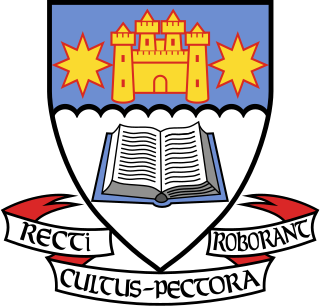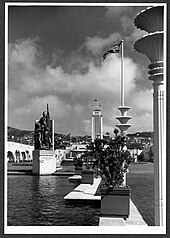
The New Zealand and South Seas Exhibition was an international exhibition held in Dunedin, New Zealand from 26 November 1889 to 19 April 1890. A previous exhibition had been held in 1865, the first world's fair in New Zealand, and a later exhibition opened in 1925.

Otago Boys' High School (OBHS) is a secondary school in Dunedin, New Zealand. It is one of New Zealand's oldest boys' secondary schools. Originally known as Dunedin High School, it was founded on 3 August 1863 and moved to its present site in 1885. The main building was designed by Robert Lawson and is regarded as one of the finest Gothic revival structures in the country. Situated on high ground above central Dunedin it commands excellent views of the city and is a prominent landmark.

Oriental Bay is a bay and suburb of Wellington, the capital city of New Zealand. Known for being both a popular beach and an opulent centre of affluence in the city, it is located close to the central business district on Wellington Harbour.
The following lists events that happened during 1939 in New Zealand.

The Dunedin Public Art Gallery holds the main public art collection of the city of Dunedin, New Zealand. Located in The Octagon in the heart of the city, it is close to the city's public library, Dunedin Town Hall, and other facilities such as the Regent Theatre.
The New Zealand and South Seas International Exhibition was a world's fair held in Dunedin, New Zealand, from 17 November 1925 until 1 May 1926, which celebrated that country and the South Seas. It was the third such exhibition held in Dunedin, with earlier exhibitions in 1865 and 1889. The exhibition had over 3 million visitors. It had added a new 'Special Exhibits' section focusing on art and craftwork made by women, a breakthrough that lifted the profile of women's art and craftwork.

Edmund Anscombe was one of the most important figures to shape the architectural and urban fabric of New Zealand. He was important, not only because of the prolific nature of his practice and the quality of his work, but also because of the range and the scale of his built and speculative projects. These extended from conventional essays to monumental urban schemes informed by his international travel, especially in America. His influence was specifically felt in Dunedin, Wellington, and the rebuild of Hastings following the 1931 Hawkes Bay Earthquake. He also realised projects in Alexandra, Invercargill, Palmerston, Palmerston North, Rotorua, Waimate North and Wānaka. His key works include the 1925–26 New Zealand and South Seas International Exhibition, the 1940 New Zealand Centennial Exhibition, the Herd Street Post and Telegraph building, Anscombe Flats, the Empire Deluxe theatre and his work on the clocktower complex – including specifically the Archway Building and Marama Hall – effectively re-conceiving the design of the University of Otago's historical core. His sister was painter Eliza Anscombe

Rongotai is a suburb of Wellington, New Zealand, located southeast of the city centre. It is on the Rongotai isthmus, between the Miramar Peninsula and the suburbs of Kilbirnie and Lyall Bay. It is known mostly for being the location of the Wellington International Airport. It is roughly in the centre of the Rongotai electorate, which is much bigger than the suburb.
Gummer and Ford was an architectural firm founded in 1923 in Auckland, New Zealand, by William Gummer and Charles Reginald Ford. It was among the country's best-regarded architectural firm of the first half of the 20th century, designing numerous iconic buildings, including the former National Art Gallery and Dominion Museum in Wellington and the old Auckland Railway Station. Eighteen of the company's buildings have been registered as significant historic places by Heritage New Zealand. In 2006 an exhibition of their work was staged at The University of Auckland's Gus Fisher Gallery, and in 2007 the firm was described as 'the best architectural practice of all time in New Zealand'.

The 1893 women's suffrage petition was the third of three petitions to the New Zealand Government in support of women's suffrage and resulted in the Electoral Act 1893, which gave women the right to vote in the 1893 general election. The 1893 petition was substantially larger than the 1891 petition, which had around 9,000 signatures, and larger still than the 1892 petition, which contained some 20,000 signatures. The third petition was the largest petition presented to Parliament at that point with nearly 32,000 signatures. The petition was signed in various parts of the country by women, aged 21 or older, who signed their names and addresses. At least 20 men also signed the petition.

Hōri Pukehika was a New Zealand Māori tribal leader and woodcarver.

Eileen Olive Deste was a New Zealand photographer. Deste was heavily involved in photographing the New Zealand Centennial Exhibition.

Parliament House, in Lambton Quay, Wellington, is the main building of the New Zealand Parliament Buildings. It contains the Parliament's debating chamber, speaker's office, visitors' centre, and committee rooms. It was built between 1914 and 1922, replacing an earlier building that burned down in 1907. Parliament started using the yet to be completed building from 1918. Parliament House was extensively earthquake strengthened and refurbished between 1991 and 1995. It is open for visitors almost every day of the year, and is one of Wellington's major visitor attractions. Parliament House is a Category 1 historic building registered by Heritage New Zealand.
Lily Attey Daff was a British-born designer and artist who worked in New Zealand and published watercolour paintings and line drawings of many native New Zealand birds and flowers.
Louise Magdalene Teowaina Wallscott was a Māori activist, teacher and weaver.

The St Helens Hospitals were maternity hospitals located in seven New Zealand cities. They were the first state-run maternity hospitals in the world offering both midwifery services and midwifery training. The first hospital opened in 1905 in Wellington and the last one in Wanganui in 1921. The services of the St Helens Hospitals were gradually incorporated into other hospitals and the last hospital to close was in Auckland in 1990.

Elizabeth Matheson was a New Zealand potter. Her works are held at the Museum of New Zealand Te Papa Tongarewa and at the Auckland War Memorial Museum. She was awarded the British Empire Medal for services to pottery.
Thomas George Gordon Beck was a New Zealand civil engineer who had a leading role in public works engineering projects in New Zealand.
The Winter Show Building on Hutchison Rd, Wellington was built in 1928 by the Wellington Show Association as a permanent home for the Winter Show, an annual trade fair promoting agriculture, trade and industrial innovations. In 1998 it became the home of Te Whaea, National Dance & Drama Centre.
Kate Mary Ogston was an artist in Dunedin, New Zealand. She was known for floral and landscape paintings.















